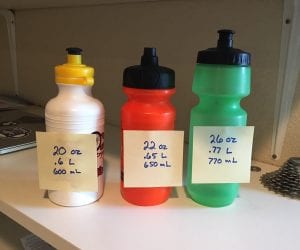
Math time: How much water can a cyclist weighing 75kg (about 165lbs) lose before exceeding 2% of their body mass/weight?
With all of the wattage figures Zwifters throw out, I know your math skills are amazing, so you immediately came up with 1.5kg or 3.3lbs of water, right? So, how long does it take to lose this much? Given that people sweat at different rates, the range between .5L to 2.0L per hour is most often used. That means that our 75kg cyclist could lose up to 2 kg (4.4lbs) per hour under the most demanding circumstances (intense ride in hot weather), or .5 kg per hour if just cruising around the flats of London in zone 2. Extend the ride to 2 or 3 hours, and the sweat volume has the potential to really add up.
Great, but how can you turn that into useful information? Your scale. This is perhaps the best use for your bathroom scale aside from tracking long term fluctuations in body mass. Since every person has a different sweat-rate, and every ride has its own intensity level, your scale is the answer. Of course, this system assumes that you are starting the ride well-hydrated.

Step 2: Estimate your liquid needs based on your ride length and intensity (overestimate).
Step 3: Ride, trying to consume .4-.8L of fluid per hour (1 medium bottle per hour)
Step 4: Weigh yourself nude immediately after ride (after urinating if need be).
Step 5: Replace liquid at a rate of 1.5L per kg lost (roughly one large water bottle per pound, or 2 per kg)
This system can determine how your current hydration strategy is working. Did you lose water? Were you balanced? Based on this, you can adjust your liquid intake while you ride, increasing intake for higher intensity workouts. And for your next Three Sisters ride or Zwift race, you can line up those bottles proudly!
Many add carbohydrate, protein, and sodium to the liquid they drink during rides and for post-workout recovery. While this is an important part of an athlete’s nutritional arsenal, those topics will have to wait until further articles.
For now, hydrate well and Ride On!
